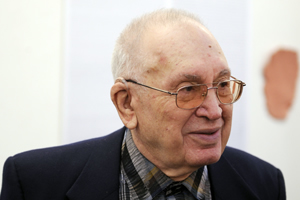University dedicates Logan center: Donors’ gift will make arts center a reality
By Josh SchonwaldNews Office
 David Logan and members of his family were the guests of honor at a recent luncheon held to dedicate the new Reva and David Logan Center for Creative and Performing Arts. Photo by Dan Dry |
|
On Wednesday, Jan. 9, the eve of the principal donor’s 90th birthday, the University formally dedicated the future site of the Reva and David Logan Center for Creative and Performing Arts — the University’s arts center slated to open in 2011.
“It’s an important day for the arts at the University of Chicago,” President told a group at the University’s Midway Studios. “The center has been the dream of many people at the University, and it’s only through the generosity of the Logan family that we will be able to realize it.”
Last May, David Logan and his family gave a $35 million gift to support the creation of the $100 million arts center. Located at 60th Street and Ingleside Avenue on the University’s South Campus, the Logan center will become a locus for all areas of artistic expression — visual arts, theatre, performance, music and film — at the University.
“It will provide a physical centerpiece for the arts at Chicago,” said Zimmer. The Logan center will give the University an opportunity to pioneer new ideas and art forms because, Zimmer explained, it will help facilitate “multiple convergences.” It will bring diverse artistic disciplines and perspectives together under one roof, and it will establish a site where intellectual inquiry and creative practice meet, he said.
James Crown, Chairman of the Board of Trustees, also spoke at the event and highlighted another convergence that the Logan center will facilitate — it will be an important venue for the University to meet the city and for the city to meet the University.
Larry Norman, Associate Professor in Romance Languages & Literatures, who was recently named Deputy Provost for the Arts, emphasized that the Logan center’s architectural planning was moving swiftly toward a 2011 opening.
Norman highlighted some of the plans for the building’s interior. In addition to spaces dedicated to individual student and faculty study and art-making, such as studios, rehearsal spaces, media classrooms, and computer and editing labs, the Logan center also will feature two studio theatres, a professional exhibition space for visual artists, a film screening room and a multipurpose hall for performances.
 Architects Tod Williams (left) and Billie Tsien speak about the design process for the building. Photo by Dan Dry |
|
A crucial goal of the Logan center is to bring the arts together under one roof — to merge the four arts in one space, to create conversations between artists, Norman said. Tod Williams Billie Tsien Architects, the critically acclaimed husband-and-wife team that is designing the center, have spent the past months meeting with faculty, staff and students to learn about the Logan center’s needs.
Known for creating vibrant spaces for the arts, such as the American Folk Art Museum in New York City and the Johns Hopkins University Mattin Student Art Center in Baltimore, Williams has said he is envisioning the Logan center as a “mixing bowl” of the arts. “We want to create spaces that lead to vibrant public spaces,” he said at the dedication. “We love this project.”
At the conclusion of the event, after a sign that would mark the future home of the building was unveiled, Dan Logan, David Logan’s eldest son, spoke briefly. “The Logan center is a big step forward for the University and for the arts in Chicago. It’s really an honor for our family to give this leadership gift. It’s great to see all the work that’s under way. This is really going to happen.”
The next step in the Logan center chronology will be the completion of the building’s schematic designs, which is expected in late spring or early summer, Norman said.
![[Chronicle]](/images/sidebar_header_oct06.gif)